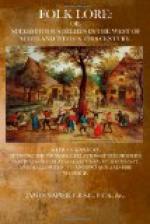A cricket singing on the hearth was a good omen, a token of coming riches to the family.
If a bee came up in a straight line to a person’s face, it was regarded as a forerunner of important news.
If a servant wilfully killed a spider, she would certainly, it was said, break a piece of crockery or glass during that day.
Spiders were, as they are still, generally detested in a house, and were often very roughly dislodged; but yet their lives were protected by a very old superstition. There is an old English proverb—
“If you wish to live and thrive,
Let the spider run alive.”
When my mother saw a spider’s web in the house she swept it away very roughly, but the spider was not wilfully killed. If it was not seen it was considered all right, but if it fell on the floor or was seen running along the wall, it was brushed out of the room; none of us were allowed to put our foot on it, or wilfully kill it. This care for the life of the spider is probably due to the influence of an old legend that a spider wove its web over the place where the baby Christ was hid, thus preserving his life by screening him from sight of those who sought to kill him. Stories of a similar character are related in connection with King Robert Bruce, and several other notable persons during times of persecution, who, while hiding in caves, spiders came and wove their webs over the entrances, which, when their enemies saw, convinced them that the parties they were in search of had not taken refuge there, or the webs would have been destroyed.
The common white butterfly was a favourite with children, and to catch one and preserve it alive was considered lucky. Care was taken to preserve them by feeding them with sugar. But the dark brown and spotted butterflies were always detested, and were named witch butterflies. Ill luck, it was believed, would attend any one who kept one alive, but to kill one was an unlucky transaction, which would be attended by evil to the killer before evening.
Beetles were held in aversion by most people, and if one was found upon the person, if they were at all nervous, it was sufficient to cause a fit, at least would set them screaming with a shudder of detestation. But there was a variety of small beetles with a beautiful bronze coloured back, called gooldies by children, which were held in great favour. They were sometimes kept by children as little pets, and allowed to run upon their hands and clothes, and this was not because of their beauty, but because to possess a gooldie was considered very lucky. To kill a beetle brought rain the following day.
The lady bird, with its scarlet coat spotted with black, was another great favourite with most people. Very few would kill a lady bird, as such an act would surely be followed by calamity of some sort. Children were eager to catch one and watch it gracefully spreading out its wings from under its coat of mail, and then taking flight, while the group of youthful onlookers would repeat the rhyme,




